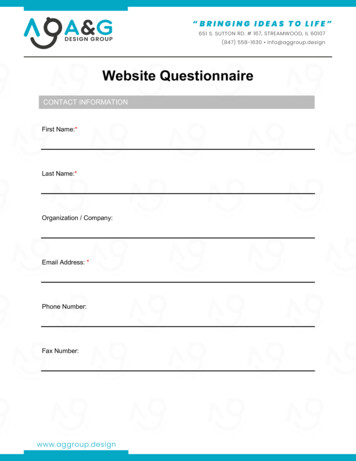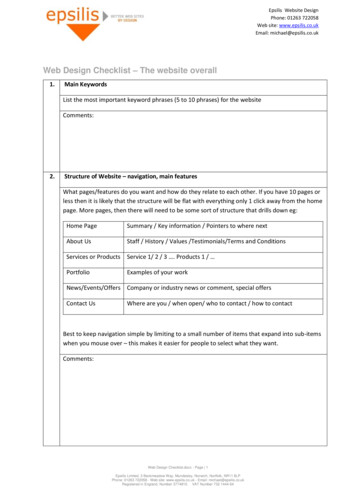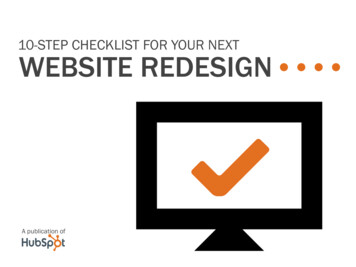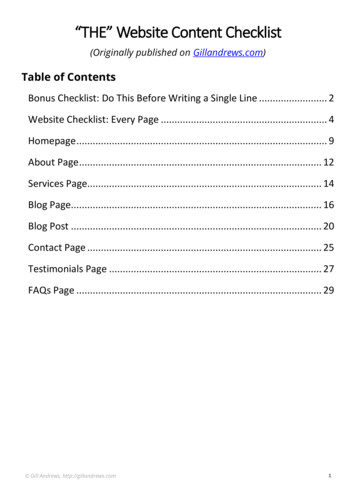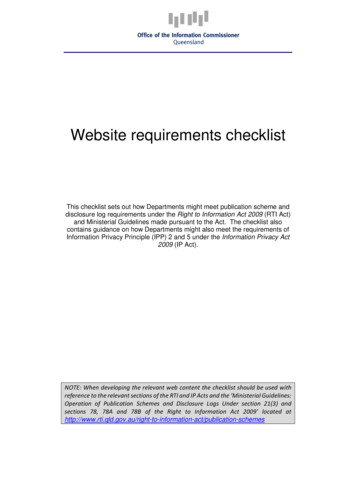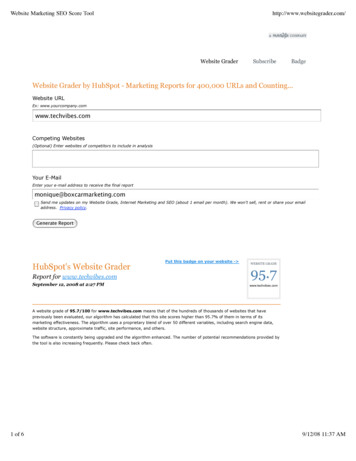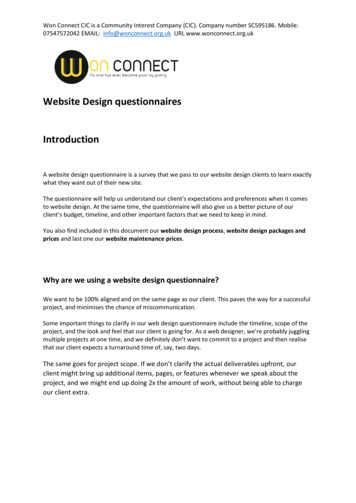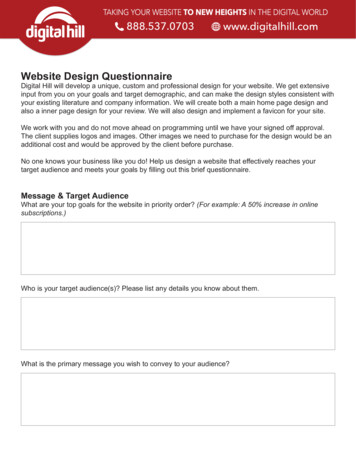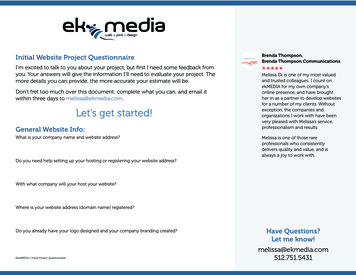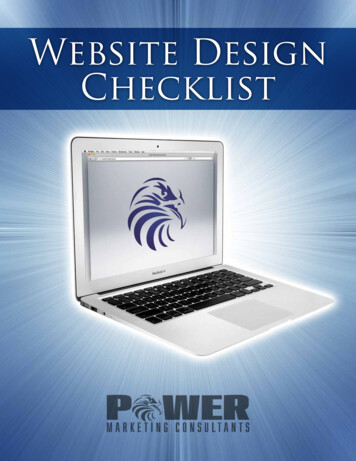
Transcription
Website DesignChecklist
Use this guide before you begin building your website to ensurethat your website maximizes its potential for your company.3 THING YOU SHOULD NEVER SAY ON YOUR WEBSITE(That I guarantee you’re already saying)Yes, it’s true—there are 3 forbidden phrases that you should never use on your website (or any marketingpiece) because they will make your results dismal. And yes, I can guarantee you are already using thesephrases right now.The 3 forbidden phrases that you should never use on your website are phrases that include platitudes. Aplatitude is defined as “words or phrases that are dull, obvious, or predictable that lackpower to create interest because they are overused, that are still commonly used asthough they were unique or distinctive.”These are words and phrases like: highest quality, biggest selection, largestinventory, best service, been in business since 1776 BC, family owned,gets the job done right the first time, fast, residential and commercial, freeestimates, locally owned and operated, #1 in satisfaction, we’re better,why pay more, lowest prices, we care, conveniently located, professional,experienced, affordable, board certified, we’re different, advancedtechniques, call today, dependable, etc.You can read about the problem withplatitudes in this audio program. Give us acall and we’ll loan you a copy!I’m not saying that you shouldn’t actually be these kinds of things, but I am sayingthat they are all platitudes. Every one of these statements and phrases are drearilycommonplace and predictable, they lack power to evoke interest through overuse orrepetition, and they were nevertheless stated as though they were original or significant. In modern dayadvertising (and especially in videos), platitudes rule the roost. Take a look at your website right now—Iguarantee it’s loaded with platitudes. If you don’t think your website has platitudes, then put your websitethrough these 3 evaluations and see for yourself:PLATITUDE EVALUATION 1 – Well, I Would Hope So!I want you to take a look at any statement on your website and ask yourself if a customer or prospect couldor would automatically respond with the statement, “Well, I would hope so.” Here’s a perfect example—how about a website for a personal injury attorney that says, “We help you when you’ve been injured. “Well, I would hope so—you’re a personal injury attorney, right? What else would you do? Or, how aboutthis web video for a CPA where his clients give testimonials that say, “We really like our CPA.” Well, I wouldhope so! What are they going to say, “Our CPA stinks, and he never calls us back or has our stuff ready ontime!” Everybody is going to say great things about themselves if they can get away with it. Examples likethese are infinite, but I think you get the point by now.PLATITUDE EVALUATION #2 – Who Else Can Say That?Pay close attention to this one because the question is not who else can do what you do, but who else cansay what you say. The answer is usually anyone and everyone.Here’s a headline from a local bank who says that they make you “a member of the family.” Who else cansay that? How about every single bank on the planet—that’s who! What about this other bank who saysthat they “care.” Really, you care? Who else can say these things? Anybody can! See, these statements aredrearily commonplace and predictable, and they lack power to evoke interest. And you know what, they
were nevertheless stated as though they were original or significant. Take a careful look at your website.Read any claim that you’ve made and then ask yourself this, “who else can say that?” If any competitor cansay it, then your website failed the evaluation.PLATITUDE EVALUATION #3 – The Cross Out / Write-in TestFor this evaluation, I’m going to have you cross out the name of your company on your website and thenwrite in the name of your competitor. Now tell me this, is the website still valid? If so, you’ve just failed thetest. Another way to illustrate this is to do it in reverse. Cross out your competitor’s name on their websiteand then replace it with your company’s name. Now tell me, is the website still valid? I mean really. I don’tcare if you absolutely know that you have higher quality than your competitor because your competitorcan still say that they have higher quality than you even if it’s not true.I can give you a million examples like this on websites, but go ahead and check for yourself. Here’s thedeal—if you will eliminate platitudes from your website immediately, you will start to see better results—sometimes exponentially better!THE NUMBER ONE PROBLEM WITH MOST WEBSITESMost business owners think about design when it comes to having a new websitedeveloped, but virtually nobody spends any effort considering the content. This isthe biggest problem with most websites and most web design companies—theyalways focus on design or appearance and not content.I can show you case after case where “ugly designs” completely trump beautifuldesigns simply because the content was developed in such a way to cause visitorsto take action, or to otherwise facilitate the decision making process. Black texton a white background can easily convert visitors into paying customers if themessage is right. Likewise, beautiful award winning designs can win you compliments, but who caresabout compliments if they don’t turn into paying customers, right?If your web design company asks you questions like, “what colors do you like?” or “what do you want yourwebsite to say?” or “when can you get the content of your website to me?” then you should probably lookelsewhere. This shows that they have no focus on effective content.At Power Marketing, we are different because we include strategic marketing consulting with all of ourweb design packages. We use our proprietary Power Marketing Program to create strategic marketingcontent for your website before we even begin the actual design process.HOW TO TEST YOUR WEBSITE TO SEE IFIT’S ACTIVELY ENGAGING YOUR PROSPECTSThis test is probably not what you were expecting. But here’s what you need to do—think back to thetime when you had your website created for your company. Now here’s the question—how much did youpay to have the content of that advertisement strategically created and formulated to ensure maximumresults? If you’re like most businesses, you probably paid nothing, right? 99.9% of the time, you onlypaid to have the website designed. The content was usually just thrown together by the designer or the
salesperson! But most of the time, the designers ask you to provide them with the content, right?Think about it—the most important part of your website—that is, the content and message—was eitherignored by the designer or put together for free by the designer (who usually doesn’t have any idea howto create good messaging anyway). And have you ever heard the saying, “you get what you pay for?”Well, I hate to tell you this, but if you never paid anybody to create the actual message or content for yourwebsite, then you got what you paid for.Another way to test this out is to simply look at your existing website analytics and see how long peopleare spending on your website on average. If they’re not spending 2 to 3 minutes or more, then you’reprobably not engaging them.4 REASONS WHY YOU SHOULD NOTUSE YOUTUBE TO HOST YOUR VIDEOSWhen posting videos online, 9 out of 10 businesses use YouTube as their video hosting provider. This is abad idea. You really should not use YouTube as a video hosting provider (i.e. to embed your videos on yourown website) for the following 4 reasons:1. If you use YouTube as a video host, then it means that your website visitors are just one click awayfrom YouTube. This could cause your visitors to actually use your website as a portal to YouTube—andwithin minutes, they’re watching funny cat videos, and they forgot all about you! At Power Marketing,we can show you how to use YouTube to send traffic to your website, instead of sending traffic fromyour website to YouTube.2. Mobile Users who are using an iPad, iPhone, or other mobile device will often be forcedto the YouTube app on their mobile device when they click to play your video. Again,this drives your customers and prospects away from you. This is even worse on a mobiledevice because they’ve actually left their mobile web browser and opened up anotherapp (the YouTube app). So, they can’t just push the “back” button to go back to yourwebsite—they have to close the YouTube app and go back to the web browser app.3. Unless you manually disable the feature (and most people don’t), once your videois done playing, YouTube will display multiple thumbnails of other videos to enticeviewers to watch something else. Oftentimes, the videos on display could actually beyour competitors since they would likely be using similar keywords. In other words,using YouTube to embed videos on your website can actually drive your visitors to yourcompetition (seriously, it happens).The YouTube App onyour mobile device oftenactivates when users visityour website from theirmobile device and watch aYouTube embedded video.4. Believe it or not, the most important element of your video, in terms of getting people to actuallyclick “play” is the thumbnail (aka posterframe). This is the still image that is displayed on the videobefore someone presses play. YouTube simply does not allow you to create a customized thumbnail.More often than not, you have to choose between 3 thumbnails that look ridiculous (especially if thethumbnail is a freeze-frame of you in the middle of speaking). Your thumbnail needs to contain aheadline that captures the prospect’s attention and makes them want to press play. YouTube simplydoesn’t allow this. Take a look at this example. The image on the left is an actual thumbnail of one ofour videos on YouTube, and the one on the right is the same video with a customized thumbnail on
our website. Which one would you be more inclined to click and watch?This is the actual thumbnail for one of our videos onYouTube (the thumbnail is generated by YouTube).This is the EXACT SAME video hosted on ourwebsite with a customized thumbnail. (Yes, ithas rounded corners on the video.)At Power Marketing, we host our client’s videos for them and triple encode all of our videos for our clientsso that they play back seamlessly in HD (high definition), SD (standard definition), and on mobile deviceswithout forcing visitors to leave the page. And yes, they work perfectly on iPads and iPhones, everytime—even when streaming over cellular networks. Additionally, we always custom create a video thumbnail sothat visitors to your website will want to push play and actually watch your video.CONSIDER YOUR WEBSITE’S POSITION WITHIN A SALES CYCLEThis is the very first and most important step in building a website, and it is most commonly overlooked.In short, you need to consider why people would be coming to your website in the first place and thenproperly manage your website content to take advantage of the sales cycle.For example, imagine a long line from 1 to 100. The number 1 represents the moment at which peoplebegin to think about buying whatever it is that you sell. The number 100 represents the moment at whichthey make the actual purchase. Let’s call this line from 1 to 100 the “Sales Cycle.” A lot goes on during thissales cycle, and you need to think about where your prospects and customers are on this cycle when theycome to your website. If they are low on the cycle—from 1 to 30—then your website should serve toimmediately push them into an educational sales system to further facilitate the decision making process.If they are high on the sales cycle—say from 70 to 99—then your website should serve to immediatelyclose the deal by facilitating the purchasing process.Checklist:Write down the top 3 reasons why someone would be visiting yourwebsite:(example 1) They are researching companies in my industry todetermine from whom they want to buy.(example 2) They have heard about our company, and they areresearching our company specifically.(example 3) They are following up on a marketing piece or advertisement that listedour website address.
Questions:Does your website immediately answer the question that the majority of your customers havein mind when visiting your website?Are the links to the top 3 answers immediately available and recognizable within about 3seconds when a visitor scans your website’s main landing page?Does your website facilitate the visitor’s decision making process?USE OF VIDEOVideo is an incredibly powerful tool that should beappropriately used on your website. However, it isimportant to ensure proper use of video so that yourcustomers do not have a frustrating experience.Questions:Does your website include a homepage video?Does your main video have a customized thumbnailwith a powerful headline that gives visitors an obvious andimmediate reason to click play?Is your main video scripted so that it offers real value to the visitor (in terms of satisfying theirneed for specific information)?Is the video properly encoded so that it plays back properly on mobile devices?Are you using YouTube as a host? (You really should not use YouTube as a host for your videoson your own website.)If you are using YouTube as a video hosting provider, make sure you have turned off the suggestedvideos feature and set up a third party player so you can customize your video thumbnail.CALL TO ACTIONYour website should have a call to action on the landing page (or pages). Thecall to action should ask the visitor to take the next step in the buying process.It could be an opt-in form, a phone call, a download, etc.Does your website have a clearly visible call to action?Does the call to action offer legitimate value to the visitor?SOCIAL MEDIA INTEGRATIONNow more than ever, it is very important to integrate social media with yourwebsite. Google, in particular, is using “social media
guarantee it’s loaded with platitudes. If you don’t think your website has platitudes, then put your website through these 3 evaluations and see for yourself: PLATITUDE EVALUATION 1 – Well, I Would Hope So! I want you to take a look at any statement on your website and ask yourself if a customer or prospect could
